The recent ruling on marriage equality by the US Supreme Court, has a ripple effect across the world
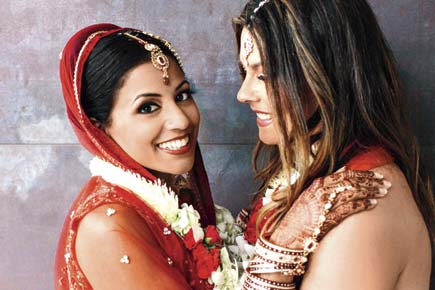
A viral image posted by popular Star Trek alumni, George Takei, pretty much sums it up. On June 26, the actor tweeted, “When I checked Twitter this morning...”, alongside a hysterical cartoon of a Zoozoo-like stand-in for himself left open-mouthed by a rainbow beaming out of his computer screen.
ADVERTISEMENT
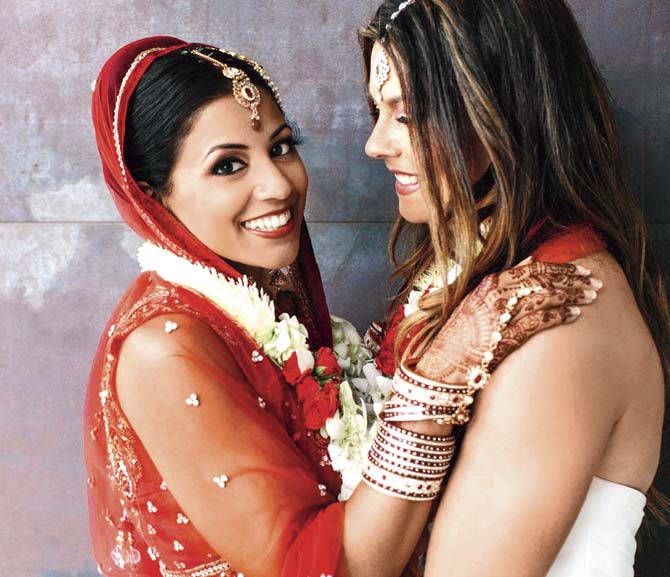
Seema (l) and her spouse Shannon were the first lesbian Indo-American couple to be married
Takei was, of course, speaking of how the teeming denizens of Facebookistan have hitched on to the rainbow bandwagon, ever since the historic ruling on marriage equality by the Supreme Court of the United States (or SCOTUS, now an acronym familiar even to Indians).
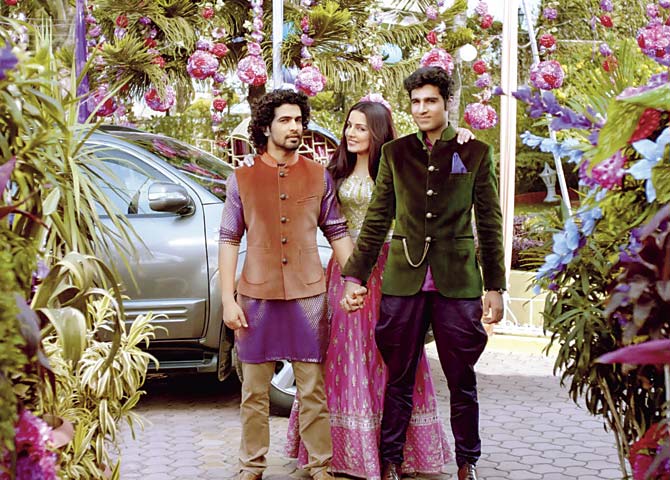
A scene from The Welcome a music video on a wedding, where a man brings home his bridegroom, not a bride. It features actor Celina Jaitley too
So, while Twitter added a cutesy rainbow heart to every use of the hashtag #lovewins, Facebook doled out whimsical rainbow makeovers to millions of profile images. My feed now resembled, quite possibly, the conveyor belt at a massive Cadbury Gems factory.
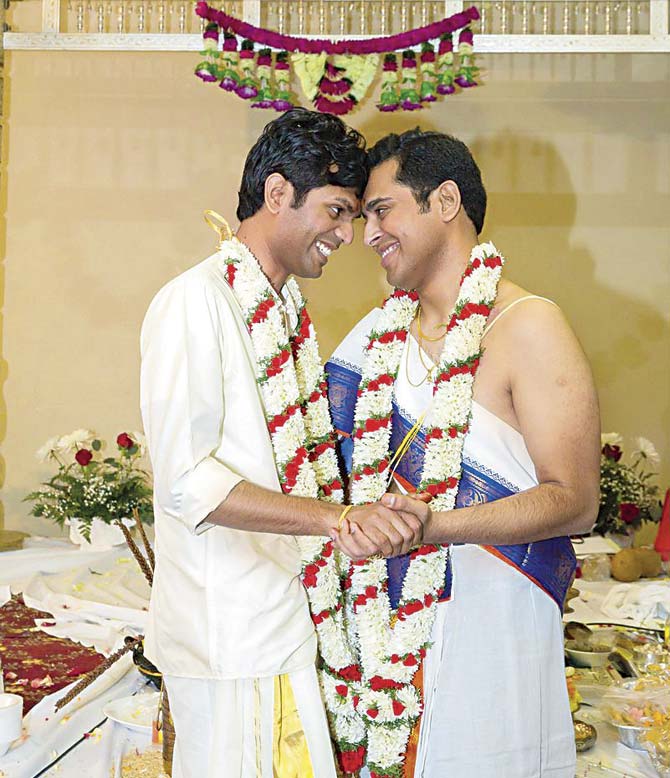
Sandeep and Karthik get married in a traditional Malayali wedding in sunny California
If, in India, it was as if the festival of colours was upon us once again, one can only guess at what the cumulative effect of such multi-hued activism (armchair or otherwise) could be on those located at the centre of the action.
Symbols
It brought to mind the arguably more aesthetic (but equally choc-a-bloc) vision of rows and rows of red boxes with pink equal signs, or the Human Rights Campaign’s symbol of equality that caught on like wildfire in 2013, when arguments in the lawsuit (actually, four same-sex marriage cases that have been brought together in this landmark case, called Obergefell vs Hodges) were first being heard.
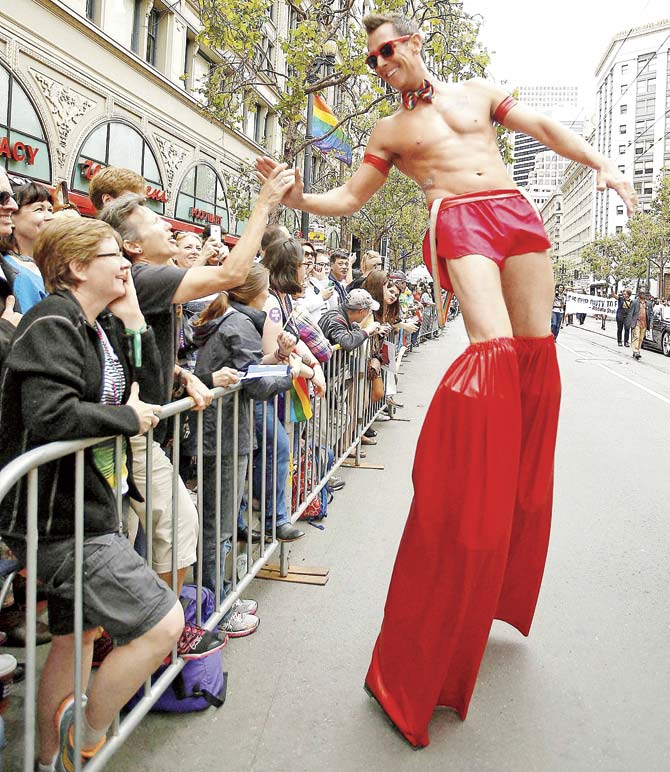 A performer greets spectators during the 45th annual San Francisco Gay Pride parade as there was a large turnout following the landmark Supreme Court ruling that said gay couples can marry anywhere in the US. Pic/AP
A performer greets spectators during the 45th annual San Francisco Gay Pride parade as there was a large turnout following the landmark Supreme Court ruling that said gay couples can marry anywhere in the US. Pic/AP
The three seconds it took to change one’s profile image allowed people to become instant signatories to a happening cause. There was (and is) the whiff of lazy clicktivism to this, as legal scholar Cass Sunstein observed in The New York Times, “The experience of the echo chamber is easier to create with a computer than with (the) forms of political interaction that preceded it,” but there is no denying the impact of such a profusion of ‘right noises’.
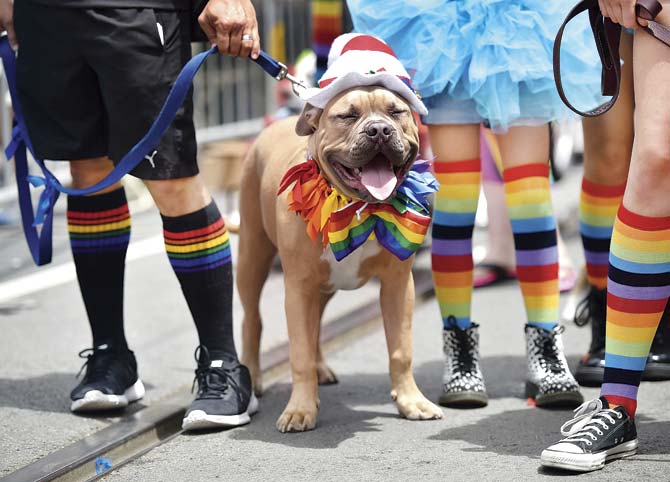
A costumed dog stands along Market Street during the annual Gay Pride Parade in San Francisco, California after the US Supreme Court’s landmark ruling legalising same-sex marriage nationwide. Pic/AFP
In India, this was experienced first-hand with the #GayForADay campaign, that took off in the weeks after the egregious turning back of the clock on gay rights by Justice (or ‘Injustices’) Singhvi and Justice Ganguly in December, 2013.
Thousands changed their display pictures to ones in which they could be visibly seen kissing (very chastely, in most cases) a person of the same gender. However reductive that may appear to be now, word on the ground can sometimes begin with such seemingly flighty measures, positioned out in the open, and involving all kinds of people, both gay and straight.
Certainly, for those in the gay community, starved of images of affirmation, these passing trends serve the purpose of making them feel cursorily a part of the very society. Ironically, it is a society that has traditionally excluded them, even if giant strides made elsewhere can seem irrelevant in an India where the specter of Section 377 still hangs like the sword of Damocles over most queer lives.
India
In a shrinking world, many gay Indians are no longer insulated from global changes that impact them, both positive and negative, drawn selectively, of course, from what the mainstream media tends to highlight. We are equally repulsed by anti-gay butchery in Uganda and Iraq, as we’re enthused by the victory marches in Ireland or the US, which have the marked the culmination of years of struggle, something we are quite familiar with.
Many Indians have benefited from marriage equality laws (or indeed, civil partnership statutes) that exist outside their own country, and not just in the notional sense of skipping over to Nepal for a quick ceremony. Many human-interest stories have emerged over the years, only sporadically documented, ever since the civil union between Wendell Rodricks and Jerome Marrel.
Their Goa reception was dubbed the country’s first gay wedding in 2003, although as much as a decade earlier, Aditya Advani and Michael Torr had exchanged garlands in a Hindu ceremony organised by Advani’s mother. It was the earliest instance of an Indian gay marriage on record, with all the pomp and panoply.
Last week, when news of the ruling first broke, account manager Rhea Fadnavis, 26, was in Paris with her partner, Annette Nicoll, preparing to celebrate their first Paris Pride as a legally wedded couple. “We were overjoyed when we read the news! It was such a warm feeling. I wish there comes a day when ‘gay marriage’ doesn’t make news anymore and is acceptable as heterosexual marriage,” she said.
Although she came from a volatile environment in a broken home, Fadnavis had never shied away from the idea of marriage. Over five years ago, she moved to the UK from Mumbai to complete her education. There she met Nicoll and after a whirlwind courtship they were married in a registry wedding last year, in a ceremony sans any kind of religious trappings. It was only a couple of months after Britain had passed legislation to allow same-sex marriage (although civil partnerships have been in vogue since 2004).
“At the end of the day, signing those papers is just a means to an end, to spend your life together as a ‘unit’ recognised by the state. It meant we were protected, come rain or shine, and we were each other's next of kin, so we were very happy to do it,” she said.
Asked if she would have liked a wedding in India, Fadnavis is emphatic, “I never would have wanted a wedding in India, even though all my close friends are there. I would rather be in a supporting and accepting environment on one of the happiest days of my life.”
In May, the Irish referendum on gay marriage hit headlines around the world. Approved with more than 62 per cent of votes cast, it marked the first time a country had legalised same-sex marriage in a nationwide popular vote, as stated by The Guardian. Indian Karan Chugh, 28, who works in Dublin as a business consultant, was already planning to enter into a civil partnership with his long-standing partner, Conor O’Byrne, later this year.
“This was to ensure I could have the access to return to the country anytime without a visa, because my work takes me to different parts of the world,” he said. Chugh wanted to ensure that their future was secured, even if they were to enter into a long-distance relationship later on.
Unlike in the UK, with an Irish civil partnership, it would have been difficult for Chugh to have a legally recognised relationship with the biological children of his partner, and vice versa (even though the couple hasn’t yet thought of raising children). Now, with the constitutional amendment slated to be in place very soon, parity in all respects has been established, to much salutations the world over.
Chugh takes a contrary view of the mêlée. “Obviously those changes are important but I saw the referendum as a huge ego clash between the Church and gay men. Apart from cocking a snook at the Catholics who have branded us as all kinds of bad, I don’t think this overhyped campaign will make too much of a difference,” he signs off.
Laws
Back in India, even as the struggle for decriminalisation continues (or remains in limbo), some recent rumblings have registered on the radar. As states in the US began legalising gay marriage one at a time, we have come across professional photo-spreads of perfect weddings featuring Indian (or part-Indian) same-sex couples. Through an Instagram haze, these were heart-warming spectacles that also seemed like faraway fairy tales.
Closer home, activist Harrish Iyer’s matrimonial ad captured eyeballs in May and has even resulted in several prospective match-ups for him, a la Mr Yogi. Perhaps we will soon see a glitzy wedding (still without legal sanction) like the one envisioned in Celina Jaitley’s music video The Welcome that was released last year, where a young man surprises his family by bringing home, instead of a comely bride, a bridegroom in a fetching red bandhgala, for the saath pheras.
Within the community, marriage is sometimes seen as one of the sturdiest bastions of heteronormativity, and perhaps, an institution that need not (or must not) be inherited in its current form, when even straight couples find it difficult to marry out of their own free will. Straight nuptials, with their unending rituals that can stretch for weeks on end, can be oppressive to those who can never hope to bring their partners home to as much felicity.
However, the struggle is for equal rights and equal dignity. The ostensible sanctity of marriage, however contentious, with all its connotations, legal safeguards, and baggage, must be available to all. Which is why, the quest for gay marriage is here to stay, and surely, the sugar rush of rainbow-coloured avatars and this profuse solidarity with international (read, American) signposts, will pave the way for changes in our country too.
The writer is a Mumbai-based playwright. He frequently writes on queer issues, and has formerly edited Bombay Dost. Some names have been changed to protect the identity of those involved.
 Subscribe today by clicking the link and stay updated with the latest news!" Click here!
Subscribe today by clicking the link and stay updated with the latest news!" Click here!







